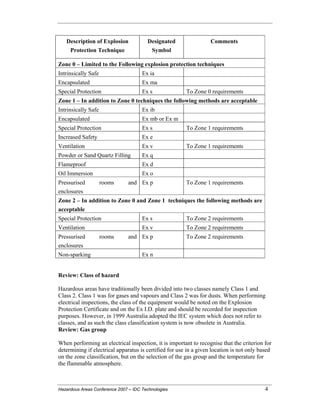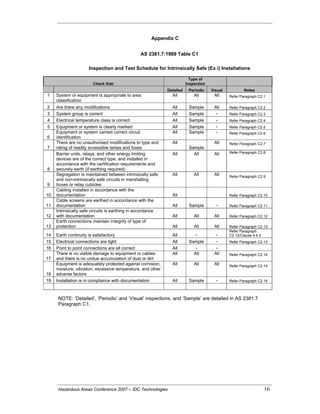4 Simple Techniques For Roar Solutions
4 Simple Techniques For Roar Solutions
Blog Article
What Does Roar Solutions Mean?
Table of ContentsThe Best Guide To Roar Solutions9 Easy Facts About Roar Solutions ExplainedThe 7-Minute Rule for Roar Solutions
In order to secure installations from a possible explosion an approach of analysing and identifying a potentially unsafe location is required. The objective of this is to ensure the proper option and setup of devices to ultimately stop an explosion and to make sure safety of life.
(https://roarsolutions.bandcamp.com/album/roar-solutions)
No tools must be installed where the surface temperature of the tools is higher than the ignition temperature of the provided hazard. Below are some usual dust hazardous and their minimum ignition temperature. Coal Dust 380C 225C Polythene 420C (thaws) Methyl Cellulose 420C 320C Starch 460C 435C Flour 490C 340C Sugar 490C 460C Grain Dust 510C 300C Phenolic Material 530C > 450C Aluminium 590C > 450C PVC 700C > 450C Soot 810C 570C The chance of the danger existing in a concentration high sufficient to create an ignition will differ from location to place.
In order to identify this threat a setup is divided right into areas of danger relying on the amount of time the hazardous is present. These areas are described as Areas. For gases and vapours and dirts and fibres there are 3 areas. Zone 0 Zone 20 An unsafe environment is highly most likely to be existing and might be present for extended periods of time (> 1000 hours per year) or even constantly Zone 1 Area 21 An unsafe atmosphere is possible but not likely to be existing for extended periods of time (> 10 450 C [842 F] A classification of T6 indicates the minimum ignition temperature level is > 85 C [185 F] Hazardous area electric equipment perhaps created for usage in greater ambient temperatures. This would certainly showed on the ranking plate e.g. EExe II C T3 Ta + 60C( This implies at 60C ambient T3 will not be exceeded) T1 T1, T2, T3, T4, T5, T6 T2 T2, T3, T4, T5, T6 T3 T3, T4, T5, T6 T4 T4, T5, T6 T5 T5, T6 T6 T6 A T Course ranking of T1 means the maximum surface area temperature created by the tool at 40 C is 450 C. Assuming the linked T Course and Temperature score for the devices are appropriate for the area, you can always make use of a tool with a much more strict Division ranking than required for the area. There isn't a clear answer to this inquiry. It really does rely on the kind of equipment and what fixings need to be lugged out. Equipment with certain examination procedures that can't be carried out in the field in order to achieve/maintain 3rd party score. Must return to the manufacturing facility if it is prior to the equipment's solution. Area Repair By Authorised Employee: Difficult testing may not be needed however specific procedures might need to be adhered to in order for the tools to preserve its third celebration rating. Authorised employees must be used to execute the work appropriately Repair need to be a like for like substitute. New element must be thought about as a direct replacement requiring no special screening of the devices after the fixing is full. Each item of equipment with a hazardous score ought to be assessed separately. These are outlined at a high degree listed below, however, for even more detailed info, please refer directly to the guidelines.
4 Easy Facts About Roar Solutions Shown
The tools register is a detailed data source of devices records that includes a minimum collection of fields to recognize each thing's location, technological specifications, Ex lover category, age, and ecological information. This info is essential for tracking and managing the tools efficiently within hazardous locations. On the other hand, for routine or RBI tasting assessments, the grade will certainly be a combination of Thorough and Close assessments. The proportion of Detailed to Shut examinations will certainly be identified by the Devices Risk, which is analyzed based upon ignition risk (the possibility of a source of ignition versus the possibility of a combustible environment )and the harmful location classification
( Area 0, 1, or 2). This variant will also influence the resourcing requirements for job prep work. Once Whole lots are defined, you can develop tasting strategies based on the sample dimension of each Great deal, which describes the variety of random devices items to be examined. To identify the called for example size, 2 facets need to be assessed: the dimension of the Whole lot and the classification of evaluation, which suggests the degree of initiative that ought to be applied( reduced, normal, or boosted )to the examination of the Lot. By combining the group of assessment with the Great deal dimension, you can then develop the proper being rejected standards for an example, indicating the allowable variety of malfunctioning items located within that example. For even more details on this process, please refer to the Energy Institute Standards. The IEC 60079 typical recommends that the optimum period in between examinations ought to not exceed 3 years. EEHA examinations will certainly likewise be performed beyond RBI campaigns as component of scheduled upkeep and equipment overhauls or fixings. These evaluations can be credited towards the RBI sample sizes within the influenced Lots. EEHA inspections are carried out to determine mistakes in electric equipment. A heavy racking up system is vital, as a single piece of tools may have numerous mistakes, each with differing levels of ignition risk. If the combined rating of both inspections is less than two times the fault rating, the Great deal is regarded acceptable. If the Whole lot is still thought about inappropriate, it must go through a full examination or reason, which might trigger stricter inspection protocols. Accepted Whole lot: The reasons for any kind of mistakes are identified. If a common failing mode is discovered, added equipment may call for maintenance. Faults are classified by intensity( Safety and security, Stability, House cleaning ), ensuring that urgent problems are examined and attended to without delay to mitigate any influence on safety and security or procedures. The EEHA database must track and tape the lifecycle of faults together with the restorative activities taken. Carrying out a durable Risk-Based Evaluation( RBI )method is vital for ensuring compliance and security in managing Electric Devices in Hazardous Locations( EEHA) (eeha courses). Automated Fault Scoring and Lifecycle Administration: Effortlessly manage faults and track their lifecycle to enhance examination precision. The intro of this assistance for risk-based evaluation further reinforces Inspectivity's placement as a best-in-class service for regulatory compliance, as well as for any type of asset-centric assessment usage instance. If you have an interest in finding out more, we invite you to request a demo and uncover just how our option can change your EEHA monitoring procedures.
The Roar Solutions Statements

In regards to eruptive danger, a harmful area is an environment in which an explosive environment is existing (or may be anticipated to be existing) in quantities that need unique safety measures for the building, installment and use equipment. eeha. In this article we explore the difficulties dealt with in the office, the danger control procedures, and the called for proficiencies to function securely
It issues of modern-day life that we produce, store or take care of a variety of gases or fluids that are considered flammable, and a variety of dusts that are regarded flammable. These materials can, in specific conditions, develop explosive environments and these can have major and terrible consequences. A lot of us recognize with the fire triangular eliminate any type of one of the three components and the fire can not happen, however what does this mean in the context of hazardous locations? When breaking this down into its most basic terms it is essentially: a mix of a specific quantity of release or leakage of a particular material or material, mixing with ambient oxygen, and the visibility of a resource of ignition.
In most instances, we can do little about the degrees of oxygen airborne, yet we can have significant influence on resources of ignition, for instance electric equipment. Harmful locations are recorded on the harmful area classification drawing and are identified on-site by the triangular "EX LOVER" indication. Below, among other vital details, areas are split right into three types depending on the risk, the likelihood and duration that an explosive ambience will exist; Area 0 or 20 is deemed one of the most harmful and Area 2 or 22 is regarded the least.
Report this page